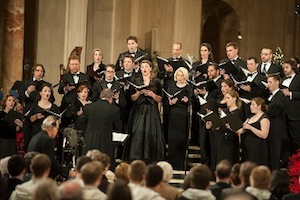Choral conducting is an exciting and deeply rewarding field. As a career, it offers the chance to serve others, a respectable salary range, and an opportunity for lifelong involvement and learning.
by Scott W. Dorsey
It can be argued that there are more choirs in the United States than any other type of ensemble. Given that there are no instruments or specialized equipment required, a chorus is easier and less expensive to develop than a band or orchestra. Additionally, singing is an innate capability in most humans. While the highest levels of a singing career require extensive training, it is possible for an amateur singer to perform well with only limited instruction.
Choral groups need qualified and dedicated leaders. There are a variety of environments where a choral conducting career can be established.
Education
The most obvious path for a choral conductor is a position in an educational institution. The vast majority of K-12 schools and colleges and universities offer students the chance to sing in various choirs.
There are numerous advantages to a job in education:
- Opportunity to encourage and influence young people in their critical formative years
- Frequent performances
- Diversity of available repertoire
- Geographical flexibility
Choral conductors serving in an educational institution have the opportunity to work with a wide variety of ensembles. From groups of fledgling singers learning the fundamentals, to doctoral candidates who rival the world’s best professional choirs, the work of choral teachers spans the entire educational horizon. And the variety of literature sung by choirs in our schools, colleges and universities covers the entire 1,500-year history of the choral spectrum, leaving no musical stone unturned.
Choral conductors serving in an educational environment work long hours, and do so with an altruistic zeal that verges on the evangelical. 75-hour weeks during the academic year are common. Off-campus performances, competitions, and additional rehearsals are expected. Most choral directors in educational environments invest time on the weekends, and do so willingly, because they know they are serving a much greater good through their efforts.
Houses of Worship
The choral art owes its very existence to the the realm of sacred music. Judaic and early Christian traditions used various forms of chant as a central part of the worship experience. Early chant repertoire constituted the seeds that eventually grew into the western choral art form.
Though sources disagree on exact numbers, most generally concur that there are well over a half million Christian and Judaic houses of worship in the U.S. alone. With virtually all of these offering some form of vocal music program, there are ample opportunities to serve in a paid capacity in a church or synagogue.
Relgious-based choral positions vary wildly, from the part-time choral conductor leading a small choir in a rural church, to the music director at a cathedral overseeing a large music staff and multiple ensembles.
The salary range in religious institutions is just as diverse. While the fledgling student conductor working their first job may earn only enough to cover the cost of gas, full-time salaries for the combined organist/choirmaster position in large churches reach into the six-figure range.
Obviously, a position in a house of worship will obligate the choral director to take part in scheduled weekend worship services. Those in full-time positions have an adjusted “weekend” during the week.
Symphonic Chorus
Most symphony orchestras include at least one concert each season that features a representative work from the choral-orchestral repertoire.
The music director will often seek a choral conductor to prepare the vocal ensemble. Though this is not usually a steady job, it can provide the creative choral musician with an annual opportunity to conduct important literature. Many choral conductors who work part-time with symphony orchestras also serve as the orchestra’s associate conductor, complete with the opportunity to conduct an occasional subscription concert.
Community Chorus
In most communities in the U.S., adult choral ensembles come together on a regular basis simply to rehearse and share the joy of performance. Generally known as community choruses, they range from small groups in a local retirement villa, to large ensembles singing barbershop literature, to enormous community programs with multiple ensembles and full-time staffs.
Opera and Musical Theatre
Most operas and works in the musical theatre genre feature numerous choral selections. These “crowd scenes” are vital to the advancement of the plot, and are frequently the grand show-stoppers of the performance. Preparing the large chorus numbers in musical theatre requires a choral leader well-versed in the vocal pedagogy and in mechanics of ensemble singing. Due to the primacy of the voice in the form, the music director of such a production is often likely to be a choral conductor. This requires a combination of musicianship, vocal acumen, conducting skill, and a willingness to work collaboratively with other artists.
Theme Parks
Whether they are small, local amusement parks or the Disney megalopolis, most theme parks offer some form of live entertainment, often in the form of a musical review. The vocal nature of these events necessitates the special skills of a choral conductor. In much the same way as a musical theatre production, the choral conductor will be called upon to coach individual singers, lead large choral production numbers, and work in a demanding environment of multiple daily performances under challenging conditions.
_______________________________________________________________________________
Dr. Scott W. Dorsey was director of education at the American Choral Directors Association. His received his DMA in Choral Conducting from the University of Iowa, an MA in Choral Conducting from California State University-Stanislaus, and a BA in Voice from Nebraska Wesleyan University. Scott has led choral programs at several colleges and universities in the U.S.
Photo credit: Interlochen Center for the Arts



Leave a Reply